Numerical Investigation on EOR in Porous Media by Cyclic Water Injection with Vibration Frequency
Abstract
:1. Introduction
2. Model and Methodology
2.1. Problem Description
2.2. Mathematical Models
2.3. Numerical Scheme
3. Model Benchmark
3.1. Problem Definition
3.2. Simulation Results
4. Results and Discussion
4.1. The Critical Frequency
4.2. The Effect of Interfacial Tension
4.3. The Effect of Viscosity of Oil
5. Conclusions
Author Contributions
Funding
Data Availability Statement
Conflicts of Interest
References
- Wei, C.J.; Song, H.Q.; Li, Y.; Zhang, Q.; Song, B.B.A.; Wang, J.L. Production Characteristics with Different Superimposed Modes Using Variogram: A Case Study of a Super-Giant Carbonate Reservoir in the Middle East. Energies 2017, 10, 250. [Google Scholar] [CrossRef] [Green Version]
- Song, J.L.; Zhang, J.; Liu, C.L.; Liu, C.; Zhu, K.K.; Yang, F.F.; Liu, X.G.; Figueiro Longo, J.P.; Alexandre Muehlmann, L.; Azevedo, R.B.; et al. Design and synthesis of pregnenolone/2-cyanoacryloyl conjugates with dual NF-kappaB inhibitory and anti-proliferative activities. Bioorg. Med. Chem. Lett. 2017, 27, 4682–4686. [Google Scholar] [CrossRef] [PubMed]
- Kong, E.; Zhu, J.; Wu, W.; Ren, H.; Jiao, X.; Wang, H.; Zhang, Z. Nifurtimox Inhibits the Progression of Neuroblastoma in vivo. J. Cancer 2019, 10, 2194–2204. [Google Scholar] [CrossRef] [PubMed] [Green Version]
- Zhang, J.; Song, H.Q.; Zhu, W.Y.; Wang, J.L. Liquid Transport Through Nanoscale Porous Media with Strong Wettability. Transp. Porous Media 2021, 140, 697–711. [Google Scholar] [CrossRef]
- Zhu, W.Y.; Li, J.H.; Lou, Y.; Song, H.Q. Experiment and Capillary Bundle Network Model of Micro Polymer Particles Propagation in Porous Media. Transp. Porous Media 2018, 122, 43–55. [Google Scholar] [CrossRef]
- Sæle, A.; Graue, A.; Alcorn, Z. Unsteady-state CO2 foam injection for increasing enhanced oil recovery and carbon storage potential. Adv. Geo-Energy Res. 2022, 6, 472–481. [Google Scholar] [CrossRef]
- Song, H.Q.; Cao, Y.; Yu, M.X.; Wang, Y.H.; Killough, J.E.; Leung, J. Impact of permeability heterogeneity on production characteristics in water-bearing tight gas reservoirs with threshold pressure gradient. J. Nat. Gas Sci. Eng. 2015, 22, 172–181. [Google Scholar] [CrossRef]
- Wan, T.; Yu, Y.; Sheng, J.J. Experimental and numerical study of the EOR potential in liquid-rich shales by cyclic gas injection. J. Unconv. Oil Gas Resour. 2015, 12, 56–67. [Google Scholar] [CrossRef] [Green Version]
- Wang, B.H.; Liang, Y.T.; Yuan, M.; Wang, J.H.; Zhang, H.R.; Li, X.J. Optimal design of oilfield surface pipeline networks for the cyclic water injection development method. J. Pet. Sci. Eng. 2018, 171, 1400–1408. [Google Scholar] [CrossRef]
- Song, H.Q.; Liu, C.C.; Lao, J.M.; Wang, J.L.; Du, S.Y.; Yu, M.X. Intelligent Microfluidics Research on Relative Permeability Measurement and Prediction of Two-Phase Flow in Micropores. Geofluids 2021, 2021, 1194186. [Google Scholar] [CrossRef]
- Wang, J.L.; Song, H.Q.; Wang, Y.H. Investigation on the micro-flow mechanism of enhanced oil recovery by low-salinity water flooding in carbonate reservoir. Fuel 2020, 266, 117156. [Google Scholar] [CrossRef]
- Sidiq, H.; Abdulsalam, V.; Nabaz, Z. Reservoir simulation study of enhanced oil recovery by sequential polymer flooding method. Adv. Geo-Energy Res. 2019, 3, 115–121. [Google Scholar] [CrossRef]
- Kulathu, S.; Dandekar, A.; Patil, S.; Khataniar, S. Low salinity cyclic water floods for enhanced oil recovery on Alaska North Slope. In Proceedings of the SPE Asia Pacific Oil and Gas Conference and Exhibition, Jakarta, Indonesia, 22–24 October 2013. [Google Scholar]
- Xie, C.Y.; Lei, W.H.; Balhoff, M.T.; Wang, M.R.; Chen, S.Y. Self-adaptive preferential flow control using displacing fluid with dispersed polymers in heterogeneous porous media. J. Fluid Mech. 2021, 906, A10. [Google Scholar] [CrossRef]
- Ji, Y.L.; Zhuang, L.; Wu, W.; Hofmann, H.; Zang, A.; Zimmermann, G. Cyclic Water Injection Potentially Mitigates Seismic Risks by Promoting Slow and Stable Slip of a Natural Fracture in Granite. Rock Mech. Rock Eng. 2021, 54, 5389–5405. [Google Scholar] [CrossRef]
- Li, Y.; Zhao, L.M.; Wang, S.; Sun, L.; Zhang, W.Q.; Yang, Y.; Hu, D.D.; Chen, Y.H. Using cyclic alternating water injection to enhance oil recovery for carbonate reservoirs developed by linear horizontal well pattern. Pet. Explor. Dev. 2021, 48, 1139–1151. [Google Scholar] [CrossRef]
- Liu, L.J.; Liu, Y.Z.; Yao, J.; Huang, Z.Q. Mechanistic study of cyclic water injection to enhance oil recovery in tight reservoirs with fracture deformation hysteresis. Fuel 2020, 271, 117677. [Google Scholar] [CrossRef]
- Pourabdollah, K. Process Design of Cyclic Water Flooding by Real-Time Monitoring. J. Energy Resour. Technol.-Trans. ASME 2018, 140, 112701. [Google Scholar] [CrossRef]
- Xie, C.Y.; Qi, P.P.; Xu, K.; Xu, J.P.; Balhft, M.T. Oscillative Trapping of a Droplet in a Converging Channel Induced by Elastic Instability. Phys. Rev. Lett. 2022, 128, 054502. [Google Scholar] [CrossRef]
- Xie, C.Y.; Xu, K.; Mohanty, K.; Wang, M.R.; Balhoff, M.T. Nonwetting droplet oscillation and displacement by viscoelastic fluids. Phys. Rev. Fluids 2020, 5, 063301. [Google Scholar] [CrossRef]
- Zhang, T.C.; Zou, Q.L.; Jia, X.Q.; Liu, T.; Jiang, Z.B.; Tian, S.X.; Jiang, C.Z.; Cheng, Y.Y. Effect of cyclic water injection on the wettability of coal with different SiO2 nanofluid treatment time. Fuel 2022, 312, 122922. [Google Scholar] [CrossRef]
- Turakhanov, A.; Tsyshkova, A.; Mukhina, E.; Popov, E.; Kalacheva, D.; Dvoretskaya, E.; Kasyanenko, A.; Prochukhan, K.; Cheremisin, A. Cyclic Subcritical Water Injection into Bazhenov Oil Shale: Geochemical and Petrophysical Properties Evolution Due to Hydrothermal Exposure. Energies 2021, 14, 4570. [Google Scholar] [CrossRef]
- Wei, C.J.; Wang, L.G.; Li, B.Z.; Xiong, L.H.; Liu, S.S.; Zheng, J.; Hu, S.M.; Song, H.Q. A Study of Nonlinear Elasticity Effects on Permeability of Stress Sensitive Shale Rocks Using an Improved Coupled Flow and Geomechanics Model: A Case Study of the Longmaxi Shale in China. Energies 2018, 11, 329. [Google Scholar] [CrossRef] [Green Version]
- Xie, C.Y.; Lv, W.F.; Wang, M.R. Shear-thinning or shear-thickening fluid for better EOR?—A direct pore-scale study. J. Pet. Sci. Eng. 2018, 161, 683–691. [Google Scholar] [CrossRef]
- Yin, D.Y.; Zhou, W. Mechanism of Enhanced Oil Recovery for In-Depth Profile Control and Cyclic Waterflooding in Fractured Low-Permeability Reservoirs. Geofluids 2021, 2021, 6615495. [Google Scholar] [CrossRef]
- Surguchev, L.; Koundin, A.; Melberg, O.; Rolfsvag, T.A.; Menard, W.P. Cyclic water injection: Improved oil recovery at zero cost. Pet. Geosci. 2002, 8, 89–95. [Google Scholar] [CrossRef]
- Stirpe, M.; Guzman, J.; Manrique, E.; Alvarado, V. Cyclic water injection simulations for evaluations of its potential in Lagocinco field. In Proceedings of the SPE/DOE Symposium on Improved Oil Recovery, Tulsa, OK, USA, 17–21 April 2004. [Google Scholar]
- Meng, X.; Zhang, Q.; Dai, X.; Xue, S.; Feng, X.; Zhang, Y.; Tu, B.; Li, X. Experimental and simulation investigations of cyclic water injection in low-permeability reservoir. Arab. J. Geosci. 2021, 14, 791. [Google Scholar] [CrossRef]
- Sun, X.F.; Zhang, Y.Y.; Wu, J.; Xie, M.K.; Hu, H. Optimized Cyclic Water Injection Strategy for Oil Recovery in Low-Permeability Reservoirs. J. Energy Resour. Technol.-Trans. ASME 2019, 141, 012905. [Google Scholar] [CrossRef]
- Yu, Y.; Sheng, J.J. Experimental investigation of light oil recovery from fractured shale reservoirs by cyclic water injection. In Proceedings of the SPE Western Regional Meeting, Anchorage, AK, USA, 23–26 May 2016. [Google Scholar]
- Zhan, J.; Fan, C.; Ma, X.L.; Zheng, Z.G.; Su, Z.Z.; Niu, Z.H. High-Precision Numerical Simulation on the Cyclic High-Pressure Water Slug Injection in a Low-Permeability Reservoir. Geofluids 2021, 2021, 3507426. [Google Scholar] [CrossRef]
- Cha, L.M.; Xie, C.Y.; Feng, Q.H.; Balhoff, M. Geometric Criteria for the Snap-Off of a Non-Wetting Droplet in Pore-Throat Channels With Rectangular Cross-Sections. Water Resour. Res. 2021, 57, e2020WR029476. [Google Scholar] [CrossRef]
- Xie, C.Y.; Balhoff, M.T. Lattice Boltzmann Modeling of the Apparent Viscosity of Thinning-Elastic Fluids in Porous Media. Transp. Porous Media 2021, 137, 63–86. [Google Scholar] [CrossRef]
- Brackbill, J.U.; Kothe, D.B.; Zemach, C. A continuum method for modeling surface tension. J. Comput. Phys. 1992, 100, 335–354. [Google Scholar] [CrossRef]
- Hirt, C.W.; Nichols, B. Volume of fluid (VOF) method for the dynamics of free boundaries. J. Comput. Phys. 1981, 39, 201–225. [Google Scholar] [CrossRef]
- Cha, L.; Feng, Q.; Wang, S.; Xu, S.; Xie, C. Pore-Scale Modeling of Immiscible Displacement In Porous Media: The Effects of Dual Wettability. SPE J. 2022, SPE-210589-PA. [Google Scholar] [CrossRef]
- Raeini, A.Q.; Blunt, M.J.; Bijeljic, B. Modelling two-phase flow in porous media at the pore scale using the volume-of-fluid method. J. Comput. Phys. 2012, 231, 5653–5668. [Google Scholar] [CrossRef]
- Eymard, R.; Gallouët, T.; Herbin, R. Finite volume methods. Handb. Numer. Anal. 2000, 7, 713–1018. [Google Scholar]
- Beresnev, I.A. Theory of vibratory mobilization on nonwetting fluids entrapped in pore constrictions. Geophysics 2006, 71, N47–N56. [Google Scholar] [CrossRef]
- Beresnev, I.A.; Vigil, R.D.; Li, W.; Pennington, W.D.; Turpening, R.M.; Iassonov, P.P.; Ewing, R.P. Elastic waves push organic fluids from reservoir rock. Geophys. Res. Lett. 2005, 32, L13303. [Google Scholar] [CrossRef] [Green Version]
- Deng, W.; Cardenas, M.B. Dynamics and dislodgment from pore constrictions of a trapped nonwetting droplet stimulated by seismic waves. Water Resour. Res. 2013, 49, 4206–4218. [Google Scholar] [CrossRef]


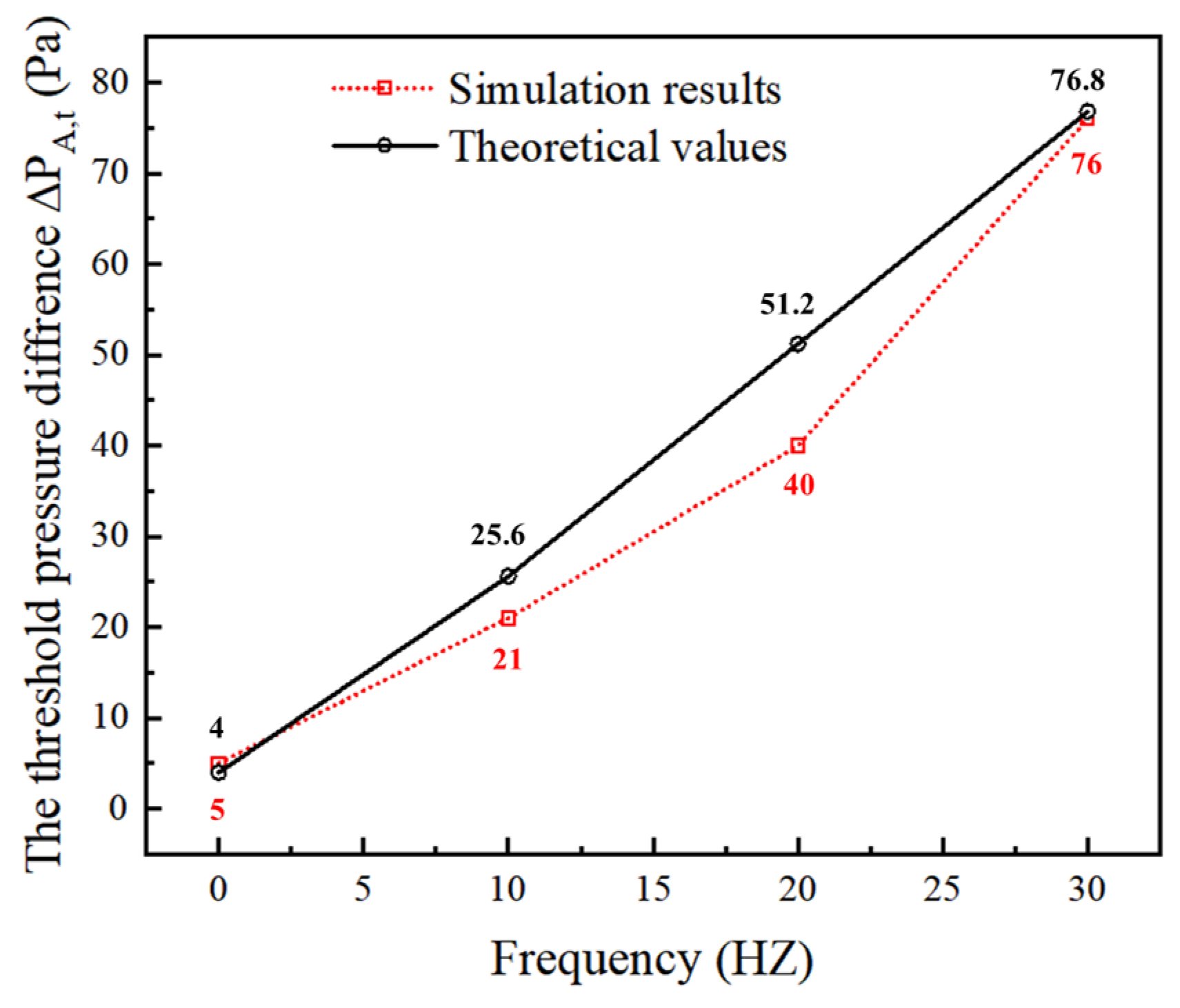
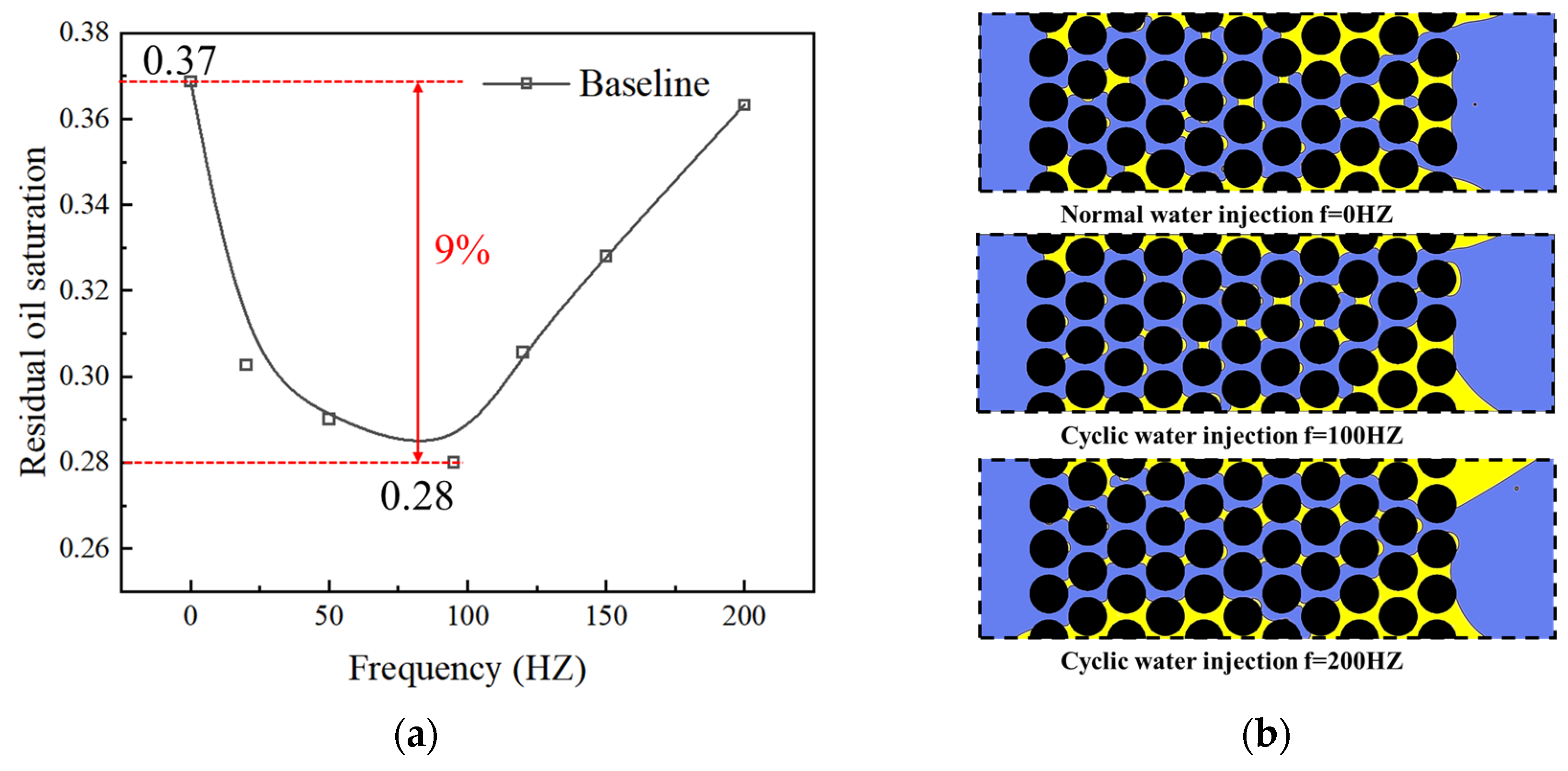
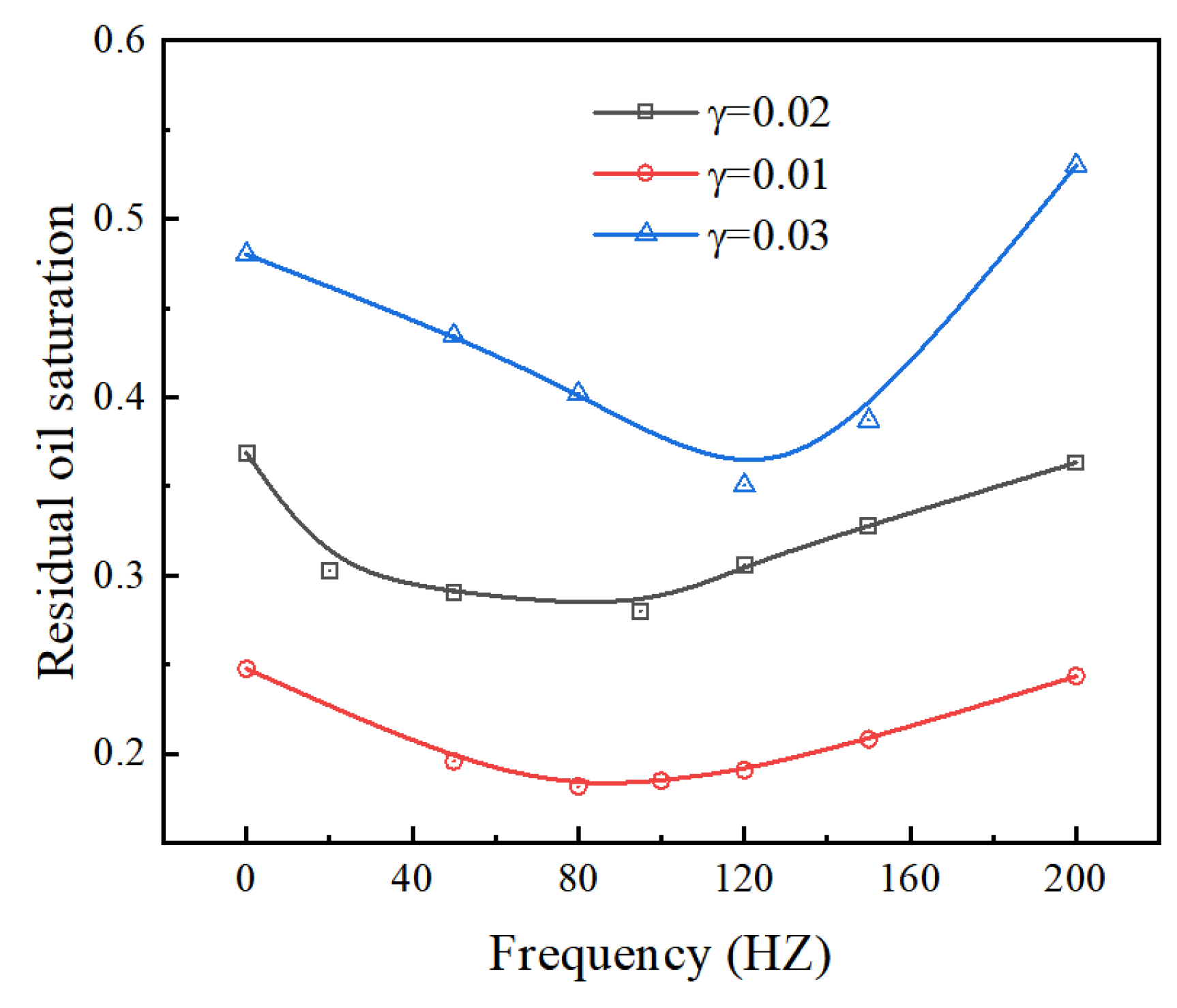
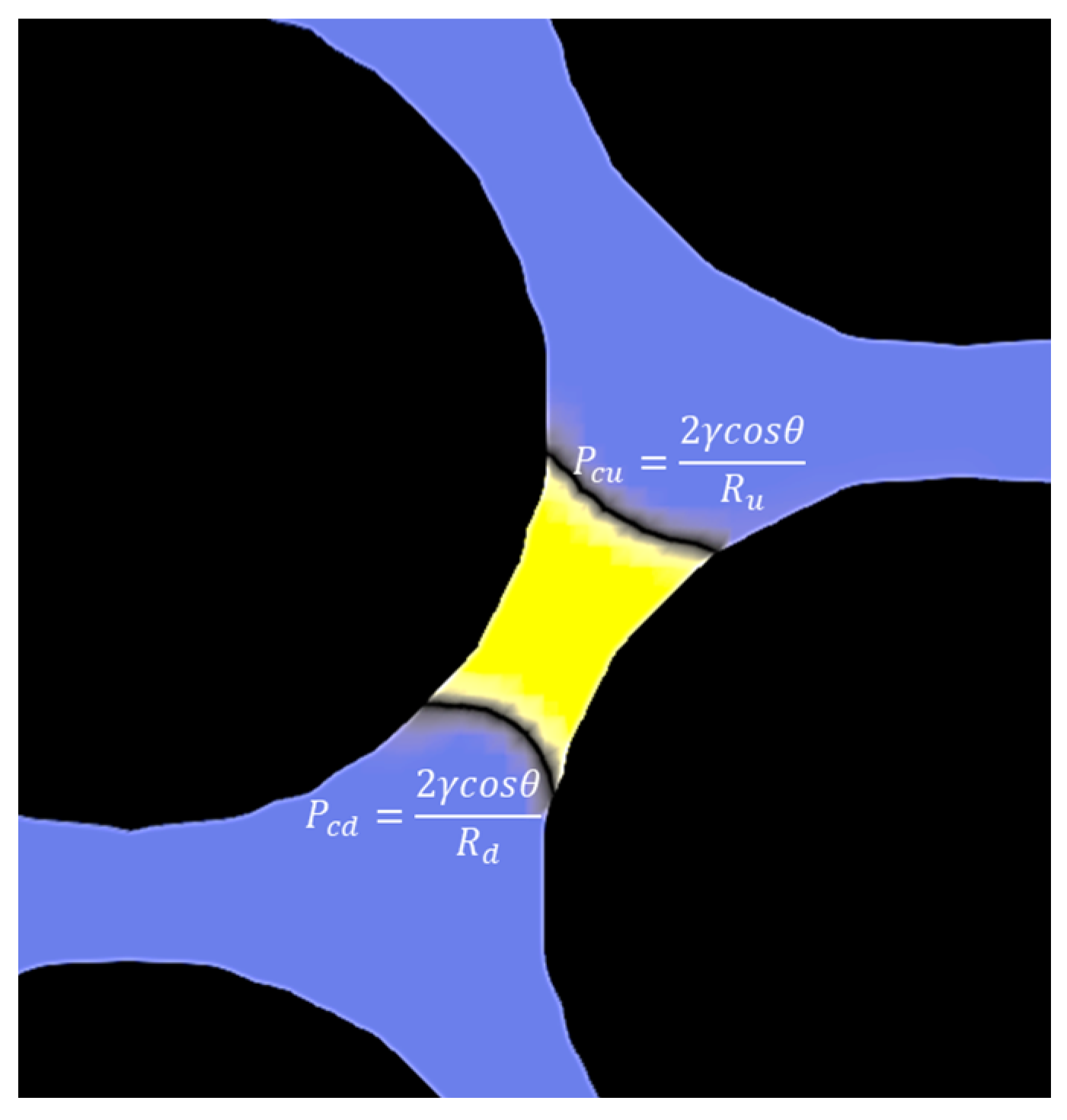
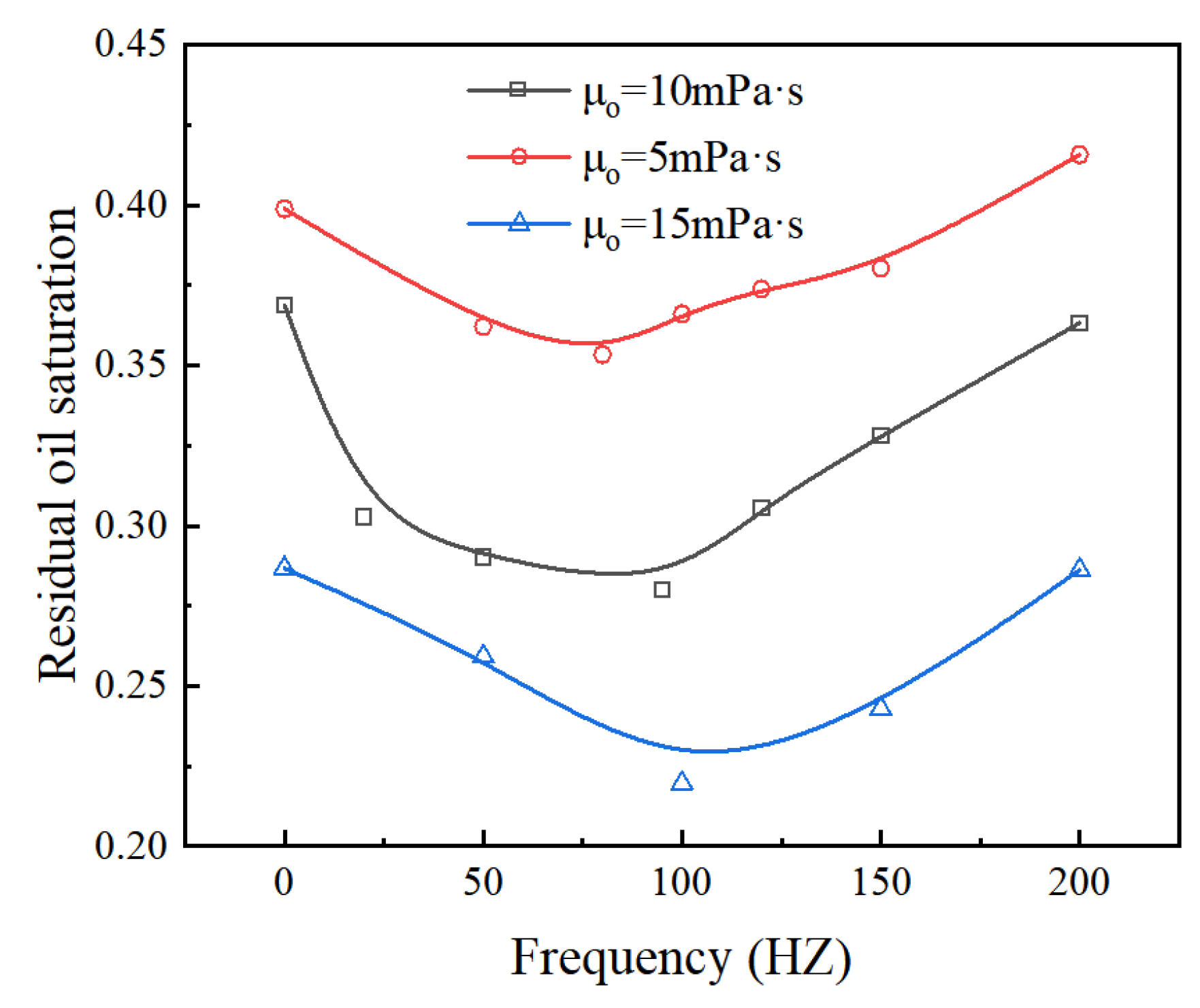
| Parameters (Unit) | Baseline Value | Discussed Value |
|---|---|---|
| (N/m) | 0.02 | 0.01, 0.03 |
| (Pa·s) | 0.01 | 0.005, 0.015 |
| (HZ) | 0 | 50, 80, 100, 120, 150, 200 |
| Parameters (Unit) | Value |
|---|---|
| The minimum radius of the throat (mm) | 0.5 |
| The maximum radius of the pore (mm) | 2 |
| The inlet position (mm) | −20 |
| The outlet position (mm) | 20 |
| The length of the sinusoidal part of the channel 2 (mm) | 20 |
| The density of the wetting phase (kg/m3) | 1000 |
| The viscosity of the wetting phase (Pa·s) | 0.001 |
| The droplet density (kg/m3) | 1000 |
| The droplet viscosity (Pa·s) | 0.01 |
| The interfacial tension (N/m) | 0.05 |
| The static contact angle (°) | 0 |
Publisher’s Note: MDPI stays neutral with regard to jurisdictional claims in published maps and institutional affiliations. |
© 2022 by the authors. Licensee MDPI, Basel, Switzerland. This article is an open access article distributed under the terms and conditions of the Creative Commons Attribution (CC BY) license (https://creativecommons.org/licenses/by/4.0/).
Share and Cite
Yang, H.; Lao, J.; Tong, D.; Song, H. Numerical Investigation on EOR in Porous Media by Cyclic Water Injection with Vibration Frequency. Water 2022, 14, 3961. https://doi.org/10.3390/w14233961
Yang H, Lao J, Tong D, Song H. Numerical Investigation on EOR in Porous Media by Cyclic Water Injection with Vibration Frequency. Water. 2022; 14(23):3961. https://doi.org/10.3390/w14233961
Chicago/Turabian StyleYang, Hongen, Junming Lao, Delin Tong, and Hongqing Song. 2022. "Numerical Investigation on EOR in Porous Media by Cyclic Water Injection with Vibration Frequency" Water 14, no. 23: 3961. https://doi.org/10.3390/w14233961
APA StyleYang, H., Lao, J., Tong, D., & Song, H. (2022). Numerical Investigation on EOR in Porous Media by Cyclic Water Injection with Vibration Frequency. Water, 14(23), 3961. https://doi.org/10.3390/w14233961









